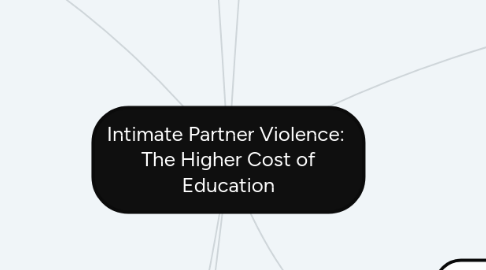
1. 16% reported that they talked to mental health services about being a victim of IPV
2. Article#4 Physical and Emotional Abuse in Romantic Relationships: Motivation for Perpetration Among College Women
2.1. Concept
2.1.1. the motivators for violence among women on college campuses as well motivations for women who were victims of IPV
2.2. Theory
2.2.1. theorist suggests that most college women use physical aggression to protect themselves from emotional abuse
2.3. Method
2.3.1. study used the Revised Conflict Tactics Scale to measure the physical aggression and injury from IPV
2.3.1.1. 5 minor acts of aggression
2.3.1.2. 7 severe acts of aggression
2.3.2. Motivations sand Effects Questionnaire was also used to assess motivations for aggression
2.3.3. Multi-dimensional measure of Emotional Abuse Questionnaire to assess four types of emotional abuse
2.4. Population
2.4.1. 348 heterosexual college women, at least 18 years old and different races - White, African American, Hispanic, Asian and mixed race
2.5. Findings
2.5.1. 95% of the women in the study reported they perpetrated at least one act of emotional abuse against a romantic partner while 24% experienced physical abuse from a partner and 23% also a victim of minor physical violence
2.5.2. common reasons for being violent or aggressive is anger , retaliation for emotional hurt, stress
2.5.3. few women admitted self defense as a motivation for perpetrating emotional abuse
2.5.4. study determined that stress or anger management & emotional regulation skills would help college women who use IPV
3. Article#5 A Gender Comparison of Motivations for Physical Dating Violence Among College Students
3.1. Concept
3.1.1. compare and understand whether men and women college students have similar or different motivators for physical dating violence
3.2. Theory
3.2.1. study contradicts feminists assumptions & theories about IPV, and that women use self-defense as an excuse for perpetrating violence
3.3. Method
3.3.1. participants completed an online study questionnaire gathering demographic info, dating violence and and motives/reasons for dating assessments
3.4. Population
3.4.1. a wide range of students from a public southeastern university - 163 males & 319 females
3.4.2. 18 years of age or older and in a current relationship of at least one month
3.5. Findings
3.5.1. study revealed that communication difficulties and self defense were the common motives for dating violence among men and women college students
3.5.2. sexual arousal was also a common motivator or motivating factor for dating violence among college men and women
4. Article#6 The Use of Mental Health Services Among Victims of Partner Violence on College Campuses
4.1. Concept
4.1.1. the likelihood of college women seeking and using mental health service as a result of IPV
4.2. Theory
4.2.1. the feminist perspective - theorizes that the male dominated social structure is based on control and power; therefore violence is a tool men use to have power and control over women
4.2.2. family violence perspective - theorizes that IPV is the result of societal and familial acceptance and that women as well as men are just as likely to use violent behavior to resolve family conflicts
4.3. Method
4.3.1. a cross-sectional survey was given to participants of an undergraduate psychology class
4.3.2. criterion required participants who had an intimate relationship within the past year lasting more than 3 months
4.4. Population
4.4.1. 200 college students mostly female between the ages 18 - 25; racially mixed - White, African American, Hispanic Asian and other
4.5. Findings
4.5.1. 86% of the participants had experienced some form of IPV
4.5.2. 42% preferred talking to their friends and family feelings and mental health
4.5.3. many did not report IPV
4.5.3.1. embarrassment
4.5.3.2. medical costs
4.5.3.3. not confident the services would help
4.5.3.4. stigmas of mental health issues
5. Article#1 Intimate Partner Violence on College Campuses: An Appraisal of Emerging Perspectives
5.1. Concept
5.1.1. influences for IPV
5.1.1.1. drugs & alcohol
5.1.1.2. attachment security
5.1.1.3. mental health conditions
5.1.1.4. peer groups
5.1.1.5. social media
5.2. Theory
5.2.1. Browler's Attachment Theory
5.2.1.1. helps explain attachment insecurities
5.2.2. Trans theoretical model of readiness
5.2.2.1. offered a new direction for change to sexual violence & evaluation
5.3. Method
5.3.1. national statistics and research studies
5.3.1.1. CDC
5.3.1.2. National Coalition against Domestic Violence (NCADV)
5.3.1.3. Office on Women's Health
5.4. Population
5.4.1. college students and young adults
5.5. Findings
5.5.1. Intervention & Prevention Programs
5.5.1.1. implement violence programs for children in the preadolescence stage of development
5.5.1.2. engage male and female college students in education prevention
5.5.1.3. target intervention programs for victims of IPV
5.5.1.4. encourage research to identify factors associated with trajectories of violent behavior
6. Article#2 Perceptions of Intimate Partner Violence among University Students: Situational and Gender Variables
6.1. Concept
6.1.1. assess college students' perception of IPV and their ability to recognize incidents of IPV
6.2. Theory
6.2.1. researchers theorize that most college students have a normalized attitude about IPV when the abuse is a form of control rather than actual physical violence
6.3. Findings
6.3.1. determined there is a complexity of attitudes about IPV when there is no evidence if physical violence
6.4. Population
6.4.1. male & female college students
6.5. Method
6.5.1. Intimate Partner Violence Recognition and Attitude Survey, a 25-item questionnaire using the four-point Likert scale
7. Article#3 Preventing Online Victimization: College Students' Views on Intervention and Prevention
7.1. Concept
7.1.1. examines the virtual ways college students are being socially victimized and discover their recommendations for intervention and prevention
7.2. Theory
7.2.1. stalking (cyberstalking or traditional stalking) should not be defined by the kind of contact with the victim but should be examined by the gray area that blends them together
7.3. Method
7.3.1. researchers gathered data from focus groups along with undergraduate students; focusing on sexual assault, dating violence and stalking
7.4. Population
7.4.1. 41 undergraduate students (24 male and 17 females) from east coast universities
7.5. Findings
7.5.1. cyberstalking and online harassment was a common concern of students
7.5.1.1. online tracking
7.5.1.2. new students concern lack of boundaries and vulnerability
7.5.1.3. prevention, intervention and education

